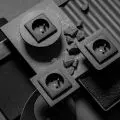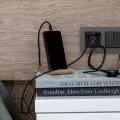Karol Perkowski of the Faculty of Architecture at the Warsaw University of Technology has designed a pump house for spa waters in Komańcza. The work is an engineering diploma done under the direction of Maciej Miłobędzki.
The thesis is an idea of a sanatorium form of recreation. In today's world, where tourism remains focused on collecting more and more numerous experiences, long stays in spa resorts seem to belong to the past.
The complex is located in Komancza
© Karol Perkowski
As the author states:
The word spa, according to its etymology, indicates healing, which cannot fully take place in the place where the disease began. [...] Specific buildings and urban planning shape ritual behavior, and thus awaken our deeply dormant imagination, for which every simplest activity can have a magical character . For example, drinking water is no longer quenching thirst, but a form of healing, and relaxing on a terrace in the face of the surrounding landscape becomes special. This architecture, unlike urban architecture, introduces theatricality into the bather's life, so that he can see the essence of the simplest things, which are framed with new meanings. The duration of the stay is to be devoted to spiritual lingering, during which the participant will be deprived of superfluous stimuli and all basic needs will be provided for. Thus, the bather will be left alone with his body and mind, which at the same time poses a great challenge to him.
wooden architecture
The author's design premise was to create a coherent narrative, based on a cultural-architectural context in which meaning and symbolism complement the relationship between local building traditions and the natural world. Thinking about the design of the pump house of spa waters, Karol Perkowski began by analyzing the features of Podkarpackie wooden architecture, especially wooden oil wells, whose task was to exploit natural deposits.
objects refer in appearance to wooden oil wells
© Karol Perkowski
The complex of designed buildings is located in the vicinity of the Monastery of the Sisters of the Holy Family of Nazareth, near the village of Komancza. The concept consists of three buildings: a mountain hostel, a host house and a pump room for spa waters. The geometric composition created from them blends into the terrain and landscape of Besid Niski.
Visitors to the complex first encounter the host's house, which houses a small bar, reception and the apartment of the facility's caretakers. On the first floor, two rooms are designed for the permanent stay of 4-6 people, i.e. the host and his family. The mountain hostel building consists of three modules. On the first floor it houses a variety of functions allowing for relaxation, group and individual work meetings and cooking. On the mezzanine level there are 4 6-bed rooms, 2 2-bed rooms and 4 bathrooms with showers.
soaring proportions of the facility
© Karol Perkowski
pump room of spa waters
The Pump Room of the Spa Waters is located above the other buildings. It is a single-module building with soaring proportions. A rack for reusable steel cups and a small washbasin are located at its entrance. Inside, there is a spring made of steel from which water is drawn. Through the open corners of the building one can access the outdoor terrace. The use of traditional materials such as wood and wood tar for roofing means that the building will continue to transform over time. The pump room is planned to provide access to several types of spa waters, including those drawn from the "Paul" spring, which is a natural monument, water from mountain streams, groundwater, filtered rainwater, and Oligocene waters.
The complex consists of three buildings: a mountain chalet, a host house and a pump room of waters
© Karol Perkowski
design solutions
The wooden structure of the designed buildings is based on four pillars set in the central part. Attached to the top part are rafters, which work as a wooden hanger structure in a spatial truss system. Taking advantage of the form's features, such as soaring and tapering upward, the author proposed to introduce natural air circulation. Cooled air through a recuperation system is forced into the ground floor section. Used or excessively hot air moves through a system of ducts and dampers to the central section, and is then exhausted to the outside through a generous skylight window.
elaborated by Dobrawa Bies
illustrations courtesy of Karol Perkowski















































